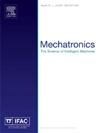基于二阶可变阻抗系统的机械手逆运动学关节加速度规划方法
IF 3.1
3区 计算机科学
Q2 AUTOMATION & CONTROL SYSTEMS
引用次数: 0
摘要
本文提出了一种机械手关节空间角加速度规划方法,以实现关节约束下的实时跟踪任务。为了提高算法性能并确保关节限制,本文提出的方法建立了一个二阶可变阻抗系统(SSVI)。二阶系统通过运动学二阶导数中的关节角加速度引入关节空间。阻抗参数随关节的不同状态而变化,可变阻抗产生的虚拟排斥力可确保关节运动在接近极限时保持在指定范围内。系统中包含的阻尼阻抗可以提高收敛速度,抑制视觉噪声等因素引起的系统振荡和振动。仿真和实验结果验证了该方法的有效性,与其他方法相比,收敛速度更快,运动更平稳。本文章由计算机程序翻译,如有差异,请以英文原文为准。
A joint acceleration planning method for inverse kinematics of manipulator based on second-order system with variable impedance
The paper presents an angular acceleration planning method for joint space of manipulator to achieve real-time tracking tasks under joint constraint. To improve the performance of the algorithm and ensure the joint limit, the proposed method establishes a Second-order System with Variable Impedance (SSVI). The Second-order System is introduced in the joint space through the joint angular acceleration in second derivative of kinematics. The impedance parameters vary with different states of joint and the variable impedance produced virtual repulsive force to ensure that the joint motions are within the specified ranges when they are close to limits. The damping impedance contained in the system can improve convergence speed and suppress system oscillation and vibration caused by factors such as the visual noise. Simulation and experiment results verify that the method is effective and has faster convergence speed and more smooth motion compared with other methods.
求助全文
通过发布文献求助,成功后即可免费获取论文全文。
去求助
来源期刊

Mechatronics
工程技术-工程:电子与电气
CiteScore
5.90
自引率
9.10%
发文量
0
审稿时长
109 days
期刊介绍:
Mechatronics is the synergistic combination of precision mechanical engineering, electronic control and systems thinking in the design of products and manufacturing processes. It relates to the design of systems, devices and products aimed at achieving an optimal balance between basic mechanical structure and its overall control. The purpose of this journal is to provide rapid publication of topical papers featuring practical developments in mechatronics. It will cover a wide range of application areas including consumer product design, instrumentation, manufacturing methods, computer integration and process and device control, and will attract a readership from across the industrial and academic research spectrum. Particular importance will be attached to aspects of innovation in mechatronics design philosophy which illustrate the benefits obtainable by an a priori integration of functionality with embedded microprocessor control. A major item will be the design of machines, devices and systems possessing a degree of computer based intelligence. The journal seeks to publish research progress in this field with an emphasis on the applied rather than the theoretical. It will also serve the dual role of bringing greater recognition to this important area of engineering.
 求助内容:
求助内容: 应助结果提醒方式:
应助结果提醒方式:


